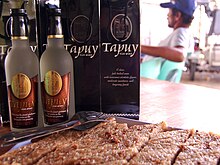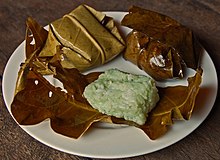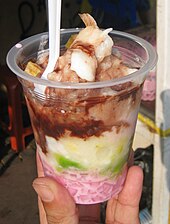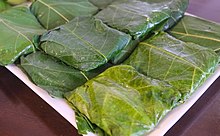Tapai
 Packaged tapai paste made from cassava inIndonesia | |
| Alternative names | Peuyeum, etc. |
|---|---|
| Type | Rice wine,alcoholic paste |
| Region or state | Southeast Asia,East Asia,South Asia |
| Main ingredients | Usually white rice,glutinous rice |


Tapai(alsotapayortape) is a traditionalfermentedpreparation of rice or other starchy foods, and is found throughout much ofSoutheast Asia,especially inAustronesiancultures, and parts ofEast Asia.It refers to both the alcoholic paste and the alcoholic beverage derived from it. It has a sweet or sour taste[1] and can be eaten as is, as ingredients for traditional recipes, or fermented further to makerice wine(which in some cultures is also calledtapai).Tapaiis traditionally made with white rice orglutinous rice,but can also be made from a variety of carbohydrate sources, includingcassavaand potatoes.[1][2]Fermentation is performed by a variety ofmouldsincludingAspergillus oryzae,Rhizopus oryzae,Amylomyces rouxiiorMucorspecies,andyeastsincludingSaccharomyces cerevisiae,andSaccharomycopsis fibuliger,Endomycopsis burtoniiand others, along with bacteria.[1][2]
Etymology
[edit]Tapaiis derived fromProto-Malayo-Polynesian*tapay ( "fermented [food]" ), which in turn is derived fromProto-Austronesian*tapaJ ( "fermented [food]" ). Derived cognates has come to refer to a wide variety of fermented food throughoutAustronesia,includingyeastedbread andrice wine.[3][4]Proto-Malayo-Polynesian *tapay-an also refers to large earthen jars originally used for this fermentation process. Cognates in modern Austronesian languages includetapayan(Tagalog),tapayan(Maguindanaon),tepayan(Iban), andtempayan(JavaneseandMalay).[3][4]
Starter culture
[edit]Tapaiis made byinoculatingacarbohydratesource with the requiredmicroorganismsin astarter culture.This culture has different names in different regions, shown in the table below. The culture can be naturally captured from the wild, by mi xing rice flour with ground spices (include garlic,pepper,chili,cinnamon),cane sugarorcoconut water,slices ofgingeror ginger extract, and water to make adough.[2]The dough is pressed into round cakes, about 3 cm across and 1 cm thick, and left toincubateon trays with banana leaves under and over them for two to three days. They are then dried and stored, ready for their next use.
| Region | China | Indonesia/Malaysia | Korea | Philippines | Thailand |
|---|---|---|---|---|---|
| Name | peh-chu, jiuyao (simplified Chinese:Men;traditional Chinese:Men;pinyin:jiǔyào;Jyutping:zau2joek1) | ragi tapai | nuruk | bubod, bubur, bubud, budbud, budbod, tapay[5] | look-paeng |
Preparation
[edit]
Traditional
[edit]Traditionally, cooked white rice orglutinous riceare fermented intapayanjars. Depending on the length of time and various processes,tapaiwill result in a large number of end products. These include slightly fermented dough used forrice cakes(Filipinogalapong); dried fermented cakes (Indonesianbremcakes); fermented cooked rice (Filipinoburo,tapay,inuruban,binubudan,binuboran;Indonesian/Malaysiantapaiortape); fermented rice with shrimp (Filipinoburo,balaobalao,balobalo,tag-ilo); fermented rice with fish (Filipinoburo); or various rice wines (Filipinotapuy,tapey,bubod,basi,pangasi;Indonesianbremwine).[5]
Modern
[edit]Fermented rice gruel/paste
[edit]In modern times, in addition to rice, different types ofcarbohydratessuch ascassavaorsweet potatoescan also be used. The general process is to wash and cook the target food, cool to about 30 °C, mix in some powdered starter culture, and rest in covered jars for one to two days. With cassava and sweet potato, thetubersare washed and peeled before cooking, then layered in baskets with starter culture sprinkled over each layer. The finished gruel will taste sweet with a hint ofalcohol,and can be consumed as is, or left for several days more to become moresour.
| Region | Cambodia | China | India | Indonesia | Korea | Malaysia | Philippines | Singapore | Thailand | Brunei |
|---|---|---|---|---|---|---|---|---|---|---|
| white rice | chao, tapai | lao-chao (Chinese:Rượu nếp than;pinyin:láozāo;Jyutping:lou4zou1),Jiuniang | tapai beras | nuruk | tapai nasi | tapay, buro, balaobalao, balobalo,galapongbigas[5] | tapai nasi | khao-mak | tapai | |
| glutinous rice | tapai | Bhattejaanr | tapai ketan | tapai pulut[6] | tapay, binuburang basi, tapay basi, inuruban, binubudan, binuboran,galapong,galapong malagkit, galapong pilit, galapong salaket[5] | pulut | ||||
| cassava | tapai ketela, tapai ubi kayu (Minangkabau), tape singkong, tape telo, peuyeum (Sundanese) |
tapai ubi kayu | binuburang kamoteng kahoy, binuburang balanghoy, tapay panggi, tapay a banggala |
Rice wine
[edit]This sectionneeds expansion.You can help byadding to it.(December 2018) |
Uses in cuisine
[edit]
Indonesia
[edit]Tapaiand its variants are usually consumed as it is; as sweet mildly-alcoholic snacks, to accompany tea in the afternoon. The sweet fermentedtapaihowever, are often used as the ingredient in a recipe of certain dishes.Sundanesecassavapeuyeumis the main ingredient forcolenak;a roasted fermented cassavatapaiserved withkincaa sweet syrup made of grated coconut and liquid palm sugar.ColenakisSundaneseportmanteauofdicocol enakwhich translates to "tasty dip".Tapai uliis a roasted block of bland-tastedketanorpulut(glutinous rice) served with sweettapai ketanortapai pulut.Thepeuyeum gorengortapai goreng,or known in Javanese asrondho royalis another example of Indonesiangorengan(assorted fritters), which isdeep friedbatteredcassavatapai.
In beverages,tapai,both cassava or glutinous rice, might be added into sweet iced concoction desserts, such ases campurandes doger.
Philippines
[edit]
In the Philippines, there are varioustapay-derived dishes and drinks. They were originally referred to by the termtinapay(literally "done throughtapay), as recorded byAntonio Pigafetta.But the termtinapayis now restricted to "bread" in modern Filipino languages. The most common use of fermented rice is ingalapong,a traditional Filipino viscous rice dough made by soaking (and usually fermenting) uncookedglutinous riceovernight and then grinding it into a paste. It is used as a base for variouskakaninrice cakes (notablyputoandbibingka). Fermented gruel-typetapayare also common, with various ethnic groups having their own versions likeTagalogandKapampanganburo,theIfugaobinuburan,and theMaranaoandMaguindanaotapay.These are usually traditionally fermented with or paired with fish or shrimp (similar to Japanesenarezushi), as inburong isda,balao-balao,ortinapayan.Rice wines derived fromtapayinclude thebasiofIlocosand thetapuyofBanaueandMountain Province.Tapuyis itself the end product ofbinuburanallowed to ferment fully.[5]
See also
[edit]- Amazake– Japanese drink made from fermented rice
- Cơm rượu– Vietnamese dessert made from glutinous rice
- Jiuniang– Chinese rice pudding dish
- Rượu nếp– Mildly alcoholic Vietnamese pudding or wine made from fermented glutinous rice
- Sake– Alcoholic beverage of Japanese origin
- Tapayan
- Tapuy– Fermented rice wine from the Luzon highlands in the Philippines
References
[edit]- ^abcNorman F. Haard; et al. (1999)."Fermented Cereals. A Global Perspective".United NationsFAO.
- ^abcIndrawati Gandjar (August 2003)."TAPAI from Cassava and Cereals"(PDF).University of Indonesia.Archived fromthe original(PDF)on 26 January 2005.Retrieved28 July2006.
- ^abBlust, Robert; Trussel, Stephen."Austronesian Comparative Dictionary: *t".Austronesian Comparative Dictionary.Retrieved21 June2018.
- ^abFitrisia, Dohra; Widayati, Dwi (2018)."Changes in basic meanings from Proto-Austronesian to Acehnese".Studies in English Language and Education.5(1): 114–125.doi:10.24815/siele.v5i1.9431.
- ^abcdeNocheseda, Elmer."The Invention of Happiness".Manila Speak.Retrieved8 December2018.
- ^Keith Steinkraus (26 March 2004).Industrialization of Indigenous Fermented Foods, Revised and Expanded.CRC Press. pp. 247–.ISBN978-0-8247-4784-8.
External links
[edit]- Dominic Anfiteatro's page on Asian cultured foodsArchived4 July 2013 at theWayback Machine

